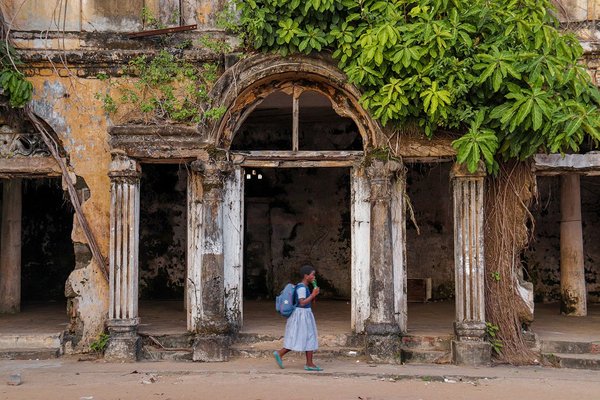Côte d'Ivoire
Grand-Bassam
The historic town of Grand-Bassam is an example of rational town planning from the colonial period.
Built in the 19th century, this seaport was the French colonial capital of Cote d'Ivoire. Europeans and Africans lived divided into separate residential quarters. It had commercial and administrative zones, in which historic buildings in a sober and functional colonial style have been preserved. The indigenous N’zima village and its vernacular architecture already existed before colonization and were later incorporated into the urban plan.
Community Perspective: Lauren visited in 2019, and found it easily accessible though without tourist infrastructure.
Site Info
Official Information
- Full Name
- Historic Town of Grand-Bassam (ID: 1322)
- Country
- Côte d'Ivoire
- Status
-
Inscribed 2012
Site history
History of Grand-Bassam
- 2012: Advisory Body overruled
- Referral suggested by ICOMOS
- 2012: Inscribed
- Inscribed
- 2009: Referred
- Include the N'zima village, and legal/operational/management issues
- Type
- Cultural
- Criteria
- iii
- iv
Links
- UNESCO
- whc.unesco.org
- Official
-
- tourisme.gouv.ci — Cote de Ivoire Tourism
All Links
UNESCO.org
- whc.unesco.org — whc.unesco.org/
Official Website
- tourisme.gouv.ci — Cote de Ivoire Tourism
News Article
- Oct. 25, 2019 whc.unesco.org — UNESCO deploys emergency mission to evaluate impact of floods in Historic Town of Grand-Bassam, Côte d'Ivoire
- March 13, 2016 news.sky.com — At least 12 people are dead after a gun attack on a beach resort in Grand-Bassam
Community Information
- Community Category
- Urban landscape: Colonial
Travel Information
Recent Connections
-
Ramsar Wetlands
Grand-Bassam -
Terrorist Attacks
March 13, 2016: 18 deaths after terrori… -
Notable Bridges
Pont de la Victoire
Connections of Grand-Bassam
- Geography
- Trivia
-
-
Built or owned by French
During French colonial period
-
- History
-
-
Located in a Former Capital
French colonial capital of Cote d'Ivoire
-
- Damaged
-
-
Terrorist Attacks
March 13, 2016: 18 deaths after terrorists attacked a beach resort in Grand-BassamSee en.wikipedia.org
-
- Religion and Belief
-
-
Cathedrals
Cathédrale Sacré Coeur
-
- Human Activity
-
-
Sea Ports
important in colonial times
-
- Constructions
-
-
Cemeteries
Colonial cemetery -
Lighthouses
20C, coastal -
Notable Bridges
Pont de la Victoire
-
- WHS on Other Lists
-
-
Ramsar Wetlands
Grand-Bassam
-
- Timeline
-
-
Built in the 19th Century
late 19th and early 20th-century colonial town (AB ev)
-
News
- whc.unesco.org 10/25/2019
- UNESCO deploys emergency mission t…
- news.sky.com 03/13/2016
- At least 12 people are dead after …
Recent Visitors
Visitors of Grand-Bassam
- Adrian Turtschi
- Ali Zingstra
- A. Mehmet Haksever
- Artur Anuszewski
- Ask Gudmundsen
- Bauchat
- Bill Maurmann
- Christoph
- edstar500
- Emili Xaus
- fedemarch92
- Gjert
- Harry Mitsidis
- Janos
- Jay T
- Jeanne OGrady
- Little Lauren Travels
- Loic Pedras
- Luis Filipe Gaspar
- Michael Novins
- Pink Bunny
- Roger Ourset
- Szucs Tamas
- Thomas Buechler
- Weecheng
Community Reviews
Show full reviews
Grand Bassam is a beach town about 45 minutes away from Abidjan. Its UNESCO status comes from the fact that it was a French colonial capital for a few years in the late 1800s. The capital was moved inland soon after it was established due to an outbreak of yellow fever, leaving behind a cluster of French colonial buildings that still remain today. Most of the site is on a barrier island/isthmus, which is walkable via a bridge from the modern town. The part on the isthmus is still sparsely inhabited, but has the eerie feeling of a ghost town due to the number of abandoned buildings. There was significant flooding in Grand Bassam in October 2019. When I visited in mid-November, the water levels were still high on the inland side, but water had cleared from the streets and there were few signs of damage.
As is a theme with some of the sites in Africa, I wish there was better upkeep and more information online. Although a few key buildings (like the costume museum in the former governor's palace) have been preserved, many of the buildings were deteriorating and some were abandoned. The upside is that there certainly were not a lot of tourists, and there seemed to be no tourist infrastructure when we went. But it was safe and easy to walk around. We wandered around for a few hours, gave a boy a tip to show us around one of the abandoned buildings, found one …
Keep reading 0 comments
